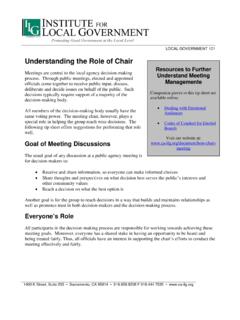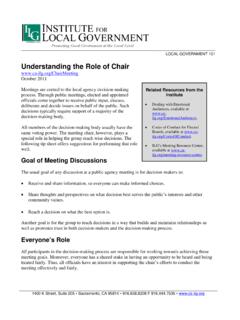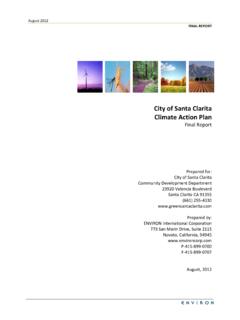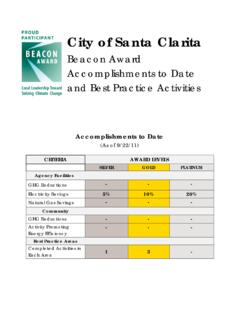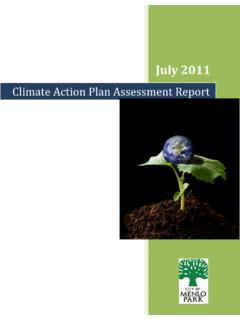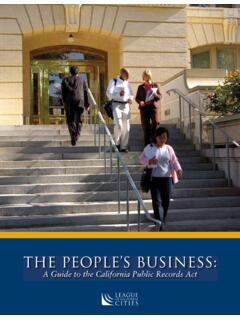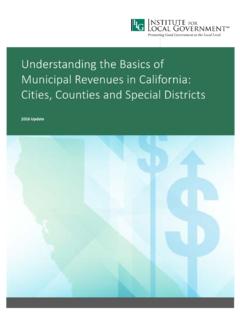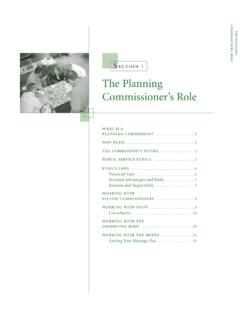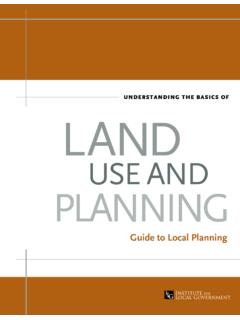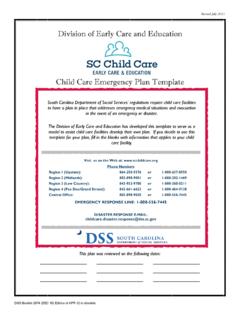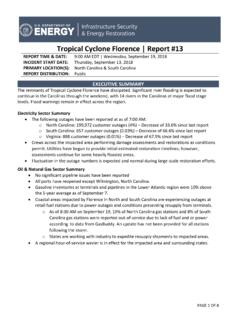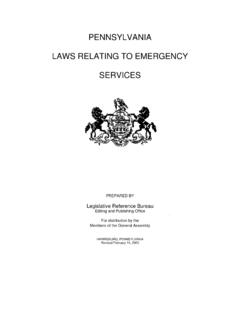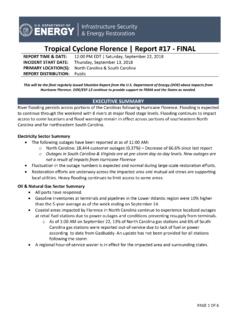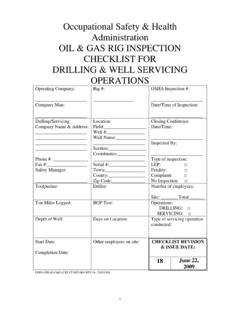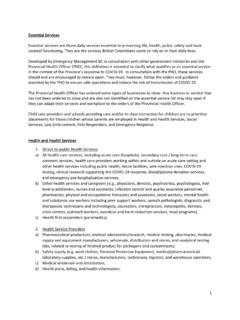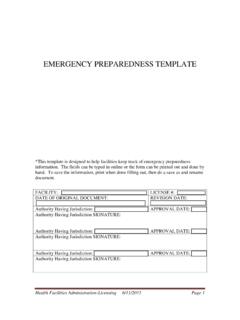Transcription of Understanding the Basics of LAND - Institute for Local ...
1 Unders ta nding the B asi cs of LAND. USE AND. PLANNING. Glossary of Land Use and Planning Terms Generous support for this publication provided by: Additional support provided by The California Endowment through a grant to the Institute 's Healthy Neighborhoods Project. Special thanks to the following individuals whose time and effort contributed to this publication: Teri Duarte, Health Program Director, Sacramento County Department of Health and Human Services Michael Stepner, Professor, New School of Architecture Julia J. Roberts, Chief Deputy County Counsel, Tulare County Charlotte Dickson, Director of Local Policy, California Center for Public Health Advocacy Cathy Creswell, Deputy Director, California Department of Housing & Community Development Jeffrey Rosenhall, Project Coordinator, California Center for Physical Activity Prepared by Steve Sanders, Lianne Dillon, Ken Loman and Charles Summerell, Institute Staff Thanks also to Bill Higgins, Senior Staff Counsel for the League of California Cities and former Director of the ILG Land Use Program, for compiling the 2004 edition of the glossary.
2 The terms in this glossary are adapted from previous editions of the Planning Commissioner's Handbook (2000 and 2004), the Planner's Pocket Guide (1992), and the Municipal Revenue Sources Handbook (2001), all published by the League of California Cities. Other sources include the California Planning Guide and the General Plan Guidelines (both published by the Governor's Office of Planning and Research), and the Glossary of Climate Change Terms (published by the Environmental Protection Agency.) Any errors or omissions are the responsibility of the Institute for Local Government. Understanding the Basics of LAND USE AND PLANNING: Glossary of Land Use and Planning Terms 2010 by The Institute for Local Government 1400 K Street, Suite 205. Sacramento, CA 95814. (916) 658-8208 FAX (916) 444-7535 Understanding the Basics of LAND USE AND PLANNING. Glossary of Land Use and Planning Terms About This Institute for Local Government About This Glossary Land use refers to the relationship While many parties play a role, Local between people and the land more agencies are at the center of decisions specifically, how the physical world regarding land use.
3 In California, city is adapted, modified, or put to use and county officials elected by Local for human purposes. This includes voters have broad authority to regulate even the non-use of lands reserved the development and use of land to as wilderness or protected from advance the health, safety and welfare human impacts. of the public. Decisions about land use are made The Glossary of Land Use and Planning by people from many walks of life. Terms is primarily intended to help Examples from the private sector Local officials and the public understand include residents choosing where to live, the terms that are commonly used in business owners opening or expanding the process of making Local land use a business, and farmers and ranchers and planning decisions. As in other raising crops and livestock. professional disciplines, many of the terms used in planning and land use are The public sector also makes important technical. It is our hope that the Glossary decisions about land use.
4 Legislatures will be a handy reference that will make and chief executives make policy and the topic of land use and planning less funding decisions that have myriad mysterious and more accessible to Local effects on land use. Courts interpret officials and community residents alike. how laws and policies apply in practice. Local , state and federal agencies then administer the laws and policies that govern the use and development of land, both public and private. Understanding the Basics of Land Use and Planning: Glossary of Land Use and Planning Terms 1. A. A. AB 32. California's Global Warming Solutions Act of 2006. The Act requires that California's greenhouse gas (GHG) emissions be reduced to 1990 levels by 2020. This is a reduction of about 30 percent from projected business as usual levels. The Act gives the California Air Resources Board (CARB) authority to identify and regulate sources of greenhouse gas emissions. The CARB's Scoping Plan for implementing AB 32 includes a wide range of strategies including reducing GHG emissions from cars and light trucks through transportation planning relating to land use.
5 Other measures include implementing green building standards that increase energy efficiency, water conservation, waste reduction, and recycling. Abandonment. A cessation of the use of the property by the owner without intent to transfer the property to another or resume the use of the property. Abatement. Reducing or eliminating the degree or intensity of a nuisance or other property-related problem, usually used in connection with zoning code or environmental program enforcement. Abutting. Having property or zone district boundaries in common; for example, two lots are abutting if they have property lines in common. Acceptable Risk. A hazard that is deemed to be a tolerable exposure to danger given the expected benefits to be obtained. Different levels of acceptable risk may be assigned according to the potential danger and how critical the threatened structure or area is deemed. For example, the level of acceptable risk from seismic activity may range from near zero for nuclear power plants and natural gas transmission lines to moderate for open space, ranches and low intensity warehouse uses.
6 Access. A way of approaching or entering a property. Access includes ingress, the right to enter, and egress, the right to leave. In zoning and subdivision regulations, recorded lots are required to have direct access to a public street or highway or to a private street meeting public standards. This guarantees entry by owners and emergency vehicles . Accessibility/Accessible. A term that describes the usability of a facility, product or service by people with disabilities. Accessory Building or Use. An activity or structure on a property that is incidental and subordinate to the main use of a site. For example, a small business office within a store might be considered an accessory use, and might not be counted in the calculation of the size of the store for zoning purposes. Acre-Foot. A volume of water one foot deep covering one acre; approximately 326,000 gallons. One acre- foot of water is enough to meet the needs of two typical families for a year. Acres, Gross.
7 The entire acreage of a site. Most communities calculate gross acreage to the centerline of proposed bounding streets and to the edge of the right-of-way of existing or dedicated streets. Acres, Net. The portion of a site that can actually be built upon. The following generally are not included in the net acreage of a site: public or private road rights-of-way, public open space, and flood ways. 2 Institute for Local Government A. Active Living Community. A community designed to provide opportunities for people of all ages and abilities to incorporate physical activity into their daily routines. By encouraging people to be more active, active living communities may improve health by lowering people's risk for health conditions such as obesity, diabetes, heart disease, osteoporosis, and depression. Ad Valorem Tax. A tax assessed based on the dollar value of an item or activity. Typical examples are property and sales taxes. Ad valorem taxes contrast with per-unit taxes, such as alcoholic beverage and cigarette taxes, which are assessed at a fixed dollar amount per unit purchased.
8 ADA. Americans with Disabilities Act. For purposes of planning and land use, federal law that generally requires that businesses and public facilities and conveyances be accessible to individuals with disabilities. Adaptation. Adjustment in natural or human systems to a new or changing environment. For example, adaptation to climate change refers to adjustment in natural or human systems in response to actual or expected climatic stimuli or their effects, which moderates harm or exploits beneficial opportunities. Adaptive Reuse. Converting obsolete or historic buildings from their original or most recent use to a new use. For example, an old manufacturing site could be converted into apartments or retail space. Administrative Decision. See Ministerial Decision. Adverse impact. A negative consequence for the physical, social, or economic environment resulting from an action or project. Aerosol. Particulate matter, solid or liquid, larger than a molecule but small enough to remain suspended in the atmosphere.
9 natural sources include salt particles from sea spray, dust and clay particles as a result of weathering of rocks, both of which are carried upward by the wind. Aerosols can also originate from human activities and are often considered pollutants. Afforestation. Planting of new forests on lands that historically have not contained forests, or have not been recently forested. Affordable Housing. Housing capable of being purchased or rented by persons whose income level is categorized as very low, low, or moderate within standards set by the California Department of Housing and Community Development or the Department of Housing and Urban Development. Agenda. A document that specifies what will be discussed at a Local agency meeting. Agendas contain a brief, general description of each item the governing body will be addressing. Local agencies generally cannot discuss and make decisions on items that are not on the agenda. See California Government Code section 54950.
10 Aging in Place. The ability to live in one's own home and community safely, independently, and comfortably, regardless of age, income, or ability level. Agricultural Preserve. Land designated for agricultural use. Understanding the Basics of Land Use and Planning: Glossary of Land Use and Planning Terms 3. A. Agricultural Urbanism. An approach to integrating growth and development with preserving agricultural resources and enhancing elements of the food system. Agriculture. Use of land for the production of food and fiber, including the growing of crops and/or the grazing of animals on natural prime or improved pasture land. Air Pollution. One or more chemicals or substances in the air in concentrations sufficient to harm humans, other animals, vegetation, or materials. Air Rights. The right granted by a property owner to a buyer to use space above an existing right-of-way or other site, usually for development. Airport-Related Use. A use that supports airport operations including, but not limited to, aircraft repair and maintenance, flight instruction, and aircraft chartering.
